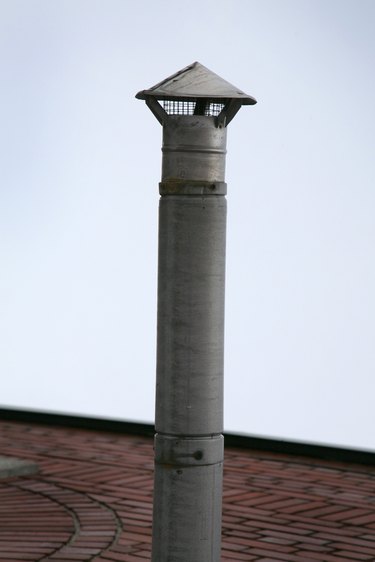Things You'll Need
Screwdriver set
Utility knife
1/4-inch self-tapping screw
Electric drill
High-temperature silicone
Caulking gun
Storm collar
Termination cap

The constant exposure to weather weakens a gas furnace roof vent's outer liner and termination cap. A rusted area on a vent pipe not only lets rainwater enter the attic but also allows potentially dangerous downdrafts to push fumes into the home's living space. A gas furnace uses a double-wall flue pipe for its vent. The inner liner carries the furnace's exhaust fumes outside, and the outer liner insulates and protects the inner liner. Always replace a gas furnace's roof vent with a compatible flue pipe, storm collar and termination cap.
Step 1
Remove the screws holding the termination cap on the end of the vent pipe, using the correct size screwdriver to turn the screws counterclockwise. Some termination caps use 1/4-inch-long screws that run through the termination cap's collar and penetrate the vent pipe's outer liner. Other termination caps use a compression band. The screw tightens the compression band, which squeezes the cap's collar against the end of the vent pipe.
Video of the Day
Step 2
Grip the vent pipe with one hand and the termination cap with the other hand. Hold the vent pipe still and turn the cap counterclockwise until the cap releases from the end of the vent pipe. Set the cap aside.
Step 3
Cut through the sealant covering the seam between the vent pipe and its storm collar with a utility knife. The storm collar slides over the end of the vent pipe and rests against the top of the roof's vent flashing. The storm collar's cone-shaped design directs rainwater away from the roof flashing.
Step 4
Lift the storm collar off the vent pipe. If excess sealant on the vent pipe prevents the collar from sliding up, scrape the sealant off the vent pipe's outer liner with the utility knife.
Step 5
Cut through the sealant covering the seam between the vent pipe and the roof flashing with a utility knife.
Step 6
Enter the attic area and locate the vent pipe joint nearest the roof flashing. Separate the two sections of vent pipe, using the same method used to remove the termination cap from the roof's vent pipe. Slide the vent pipe out of the roof flashing and into the attic.
Step 7
Push the male end of a new vent pipe up through the bottom of the roof flashing and set its female end on the male end of the vent pipe that connects to the gas furnace. Twist the roof's vent pipe clockwise one half turn with one hand, while holding the gas furnace's vent pipe still with the other hand.
Step 8
Lock the two sections of vent pipe together. If the vent pipe uses a compression band, turn the compression band's screw clockwise with the correct screwdriver until the band squeezes the vent pipe. If the vent pipe does not use a compression band, run a 1/4-inch self-tapping screw through the roof vent pipe's collar with an electric drill. Place additional screws every 4 inches around the vent pipe. Exit the attic area and climb onto the roof.
Step 9
Run a 1/4- to 3/8-inch-thick bead of high-temperature silicone around the seam between the roof flashing and the vent pipe, using a caulking gun to apply the silicone.
Step 10
Slide a storm collar over the end of the vent pipe, keeping the storm collar's wide end facing down. Push the storm collar down the vent pipe until it touches the top of the roof flashing. Cover the seam between the storm collar and the vent pipe with the high-temperature silicone, using the caulking gun to apply the silicone.
Step 11
Slip a termination cap's female end over the vent pipe's male end. If the termination cap uses a compression band, turn the band's screw clockwise with the correct screwdriver until the band squeezes the cap's collar. If the termination cap's collar does not use a compression band, run a 1/4-inch self-tapping screw through the cap's collar with the electric drill. Run an additional screw every 4 inches around the termination cap's collar.
Video of the Day